Past, Present, Future
To mark the Chromatographic Society’s 60th birthday, The Column interviewed the current President of The Chromatographic Society, Dr. Paul Ferguson, and Associate Principal Scientist for Separation Science at AstraZeneca, Macclesfield, UK, on the past, present, and future of the Chromatographic Society - and separation science.
Photo Credit: Royden Juriansz/Getty Images

To mark the Chromatographic Society’s 60th birthday, The Column interviewed the current President of The Chromatographic Society, Dr. Paul Ferguson, and Associate Principal Scientist for Separation Science at AstraZeneca, Macclesfield, UK, on the past, present, and future of the Chromatographic Society - and separation science.
- Interview by Lewis Botcherby
Q. When and why did the Chromatographic Society begin?
A: The Chromatographic Society’s evolution almost matches the development of instrumental separation science itself. Indeed it was the “buzz” created by the burgeoning influence of gas chromatography (GC) in the petroleum industry that led to the formation of the Chromatographic Society or, as it was called in its first manifestation, the Gas Chromatography Discussion Group. The Society was inspired by an international meeting of gas chromatographers held in 1955 at Ardeer in Scotland; it was formed in 1956 and later that year collaborated with groups from France and Germany to stage the first International Symposium on Chromatography (which also therefore celebrates its 60th anniversary) in London. The ISC conference has actually been running longer than the excellent HPLC conference series.
Q. Looking back on the 60-year history of the organization for which you now hold the principal leadership role, what is your own personal view of the impact The Chromatographic Society has had over these years?
A: In the UK the Society has continued to provide topical meetings that reflect the current - and sometimes future - state-ofâthe art developments in separation science such as the “Advances in Bio-Separations” meeting we held at MedImmune in 2015. Through this we hope to support and develop separation scientists in the UK. Our meetings are also excellent opportunities for networking. I like to think the Society is the “glue” that holds an increasingly disparate and evolving separation science community together and it’s great that we are able to showcase some of the best academic and industrial separation science in the UK, which could go unseen if it wasn’t for our meetings.
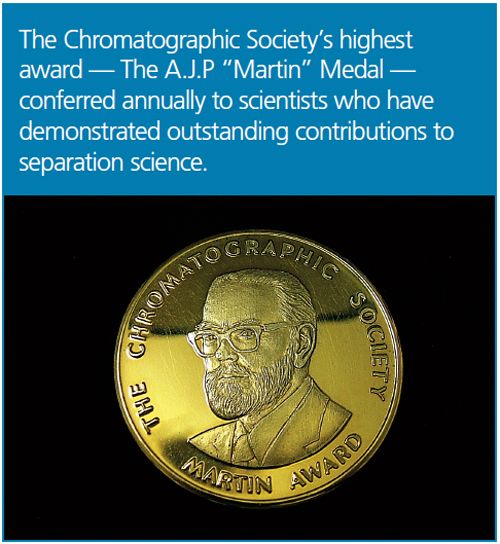
Q. What were the major successes?
A: We believe we are one of the oldest societies dedicated to supporting separation science in the world and the fact we are still around helping to shape the separation science community in the UK is important in itself! Without doubt our successful meeting programme continues to be a key strength for the society and we continue to follow the latest trends and propagate them within the separation science community. I think this is reflected by the high-quality speakers we are always able to attract from Europe and further afield to present at our meetings and the positive feedback we receive from attendees to our meetings.
Back in the 1970s and 80s, the Society was at the forefront of separation science teaching in the UK, holding high performance liquid chromatography (HPLC) training courses at the University of Surrey (organized by one of our past Presidents, Derek Stevenson) and also helping to steer approaches for the analysis of chiral compounds when that became a major concern for pharmaceutical companies.
I also feel we have continued to do our own modest bit to support the academic development of separation science in the UK through our various travel grants and research bursaries.
Q. Has the nature and role of the Society changed over the years?
A: I don’t believe fundamentally the Society has changed over the last 60 years. At our core we are still dedicated to supporting the development of chromatography and chromatographers with a principal activity of organizing meetings addressing the latest developments in the field. We still have an international reach but hopefully we have moved with the times through the development of our website, the use of social media channels such as LinkedIn, and through our publishing activities like our members-only publication ChromCom. In terms of our membership base, and while we are actively growing this, it has never been large even historically, and I see the principal activity of the Society as a meeting society where we have a strong track record.
Q. Does the Pye 104 club still exist and has its collection developed?
A: Ha! The Pye 104 club unfortunately doesn’t really exist within the Society any more. I suspect you need to be of a certain age to even know what a Pye 104 is (a GC instrument prevalent some 30 years ago)! One of our previous Presidents, Prof. Ian Wilson, started this group many years ago and still even has one of these instruments in his basement of his home along with many other historical analytical instruments. This year we will be reflecting on the history of some of Ian’s collection through various publications and on our website. While the Pye 104 club may not exist, gas chromatography is still a key focus for the Society and is reflected through our biennial “Advances in GC” meeting and our support for academic research using GC.
Our first meeting of 2016 in March revisited the heritage of our first ever meeting location (the Institute of Engineering and Technology in London) and a strong component of this meeting focused on GC with contributions from Prof. Pat Sandra of the University of Ghent and Tom Lynch of BP, alongside other star performers from
the world of separation science like Prof. Peter Schoenmakers and Prof. David McCalley.
As a direct result of the excellent speaker programme assembled by Alan Handley (our past President), this was a very popular event, which has received very positive feedback regarding the quality and
relevance of the presentations, the venue, and logistics. As ever, the event also provided a great opportunity for networking, with delegates from industry and academia, the vendors, and of course the speakers.

Q. What were the challenges you faced as President in steering the Society through these final few years towards the 60th anniversary?
A: As I mentioned earlier, the Society’s key avenue of interaction with UK-based separation science is through our meeting programme where we face a number of interrelated challenges. We are only able to fund these meetings (and our support of academic researchers) through the strong support of exhibitor organizations, and we are aware that we must maximize their investment through interaction with our attendees. Alongside this, it is becoming increasingly difficult to attract scientists to our meetings (a topic other learned society’s are also having issues addressing), which may be a result of a combination of meeting location, scientists having to focus solely on their day jobs and not having the time for external personal development activities, or maybe we need to consider more closely the topics for our meetings.
It should be noted that we are a charitable organization and all our meetings are organized by our committee in addition to their day jobs. Over the last couple of years, we have observed a significant increase from other organizations external to the UK organizing meetings with an increasing focus on separation science and related
topic meetings. This obviously provides significant competition to our meetings so we want to highlight the value of our meetings to potential attendees. The ChromSoc conferences only cost around £250 for a two-day meeting, which is incredibly cheap, and we need to publicize our meetings much more widely, emphasizing the networking opportunities and the opportunities to speak with key separation scientists in academia and industry. In 2016 we are focusing more effort on this and will be more active on LinkedIn. We have also set up a Twitter account (@chromsoc) to reach the various groups involved with separation science through that medium.
The final challenge we face is that our experience base is very strong in the pharmaceutical industry, but chromatography is increasingly being used by many industries such as the food, agrochemical, and environmental sectors. Going forwards we need to focus more attention on these sectors because there are key challenges in these areas where I think we can bring key opinion leaders together to move their separation science forward.
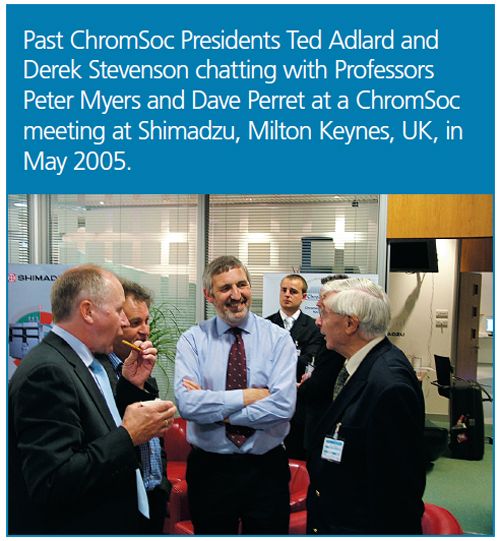
Q. So, what are the Society’s current strengths, weaknesses, opportunities, and threats, and how does your Executive plan deal with them?
A: This could be a long question to respond to! I think the Society has a number of strengths, not least the dedication of our committee. We have a number of key meetings, which are either firmly established, for example, the Reid Bioforum and our “Advances in GC” meeting, or are establishing themselves, such as the “Advances in Clinical Analysis”, which we co-organize with the RSC’s separation sciences group (RSC SSG).
I think our support base is very strong and we work with all the key scientists and companies when organizing our meetings. I also think we are well connected with academic groups in the UK, including institutions that are not necessarily recognized for separation science, which we often support through our summer studentships programme. Finally, I think we have very strong relationships with other learned societies such as the British Mass Spectrometry Society (BMSS) and the RSC SSG and we often co-organize or promote each other’s meetings, which is good for science generally.
As I eluded to earlier, membership is certainly a weaknesses for the society, simply because the larger our supporters, the more people we can promote our meetings to, the greater funding we will have to support the development of separation science, and the greater influence we could exert with for example, research funding bodies. While we are taking positive action to increase our membership, I suspect we will never be a huge society. We are also looking at opportunities to increase our overseas membership. While we have some foreign members, these numbers are low - so we would like to increase these to further improve our visibility and reach overseas too. Another issue we have is one of perception. While we occasionally partner with the RSC for some of our meetings, we are a completely separate charity and we need to do a better job promoting the Chromatographic Society brand, particularly in the UK.
In terms of opportunities, as the use and versatility of separation science continues to grow, particularly in the area of biomedical sciences, there are obviously more opportunities for the Society to move into different areas that we haven’t worked in before. Behind the scenes, another opportunity we are working very hard on is supporting efforts to bring a major international separation science conference to the UK. As these are allocated for a number of years in the future, this wouldn’t be in the near term, but this should be in the next six or seven years hopefully. By bringing a major meeting to the UK, hopefully we can rally partner organizations and industry to come together and generate momentum to focus on the development of separation science in the UK.
There are a number of threats we need to be aware of in terms of chromatography generally, some more of which we will touch on later I suspect, which may impact on Society activities. Working in analytical science, I see spectroscopic techniques being applied more and more to areas where chromatography was traditionally used, including synthetic reaction monitoring with off-line LC being replaced by on-line spectroscopic and spectrometric approaches; and off-line dissolution measurements with LC being replaced with on-line UV probes - so chromatography may be less prevalent in the future, which could have a corresponding impact on chromatography research.
The final threat may arise from the teaching of separation sciences at an undergraduate level. Separation science is becoming increasingly marginalized as a subject and is often taught to undergraduates by non-experts with little background in chromatography. If this key science is taught poorly then it is unlikely to encourage students to pursue it as a career and the Society will have fewer students to support and help develop. The Society will obviously do all we can to prevent this scenario, but it’s a big challenge and not one we can solve by ourselves.
Q. Is the Society partly responsible for the perceived weakness in UK separation science?
A: A very interesting question! I think it is fair to say that separation science in the UK isn’t as strong as it was 20 years ago. In the 1990s there were at least 12 highâprofile academic institutions undertaking separation science and some of the best industrial chromatographers in the industry. Currently there are probably around five or six Universities recognized for their separation science research in UK and industrial chromatography groups have been significantly reduced because of cuts in company size.
I think it’s a collective responsibility how this situation has arisen and a number of groups need to come together to address this situation. The Royal Society of Chemistry (RSC) who accredit University degree courses need to focus more on the analytical content of chemistry degree courses, and in particular, the separation sciences; the Engineering and Physical Sciences Research Council (EPSRC) who fund UK academic research need to focus on supporting separation science research, which is currently woefully underfunded (an area we are actively influencing); we need Universities to attract and grow separation scientists, and undertake key research in this area; we need vendor organizations to help support academic research more in the UK; industry needs to invest more on supporting academic separation science research and invest more in their own staff by developing their chromatography skills.
It’s a huge undertaking, but we feel the Society can play a role in redeveloping UK separation science through our meeting programme and providing financial support for research within our means, but we need to align all these parties to refocus separation science as a core discipline in
the UK.
Q. Given the ever-increasing rate of change in society, science, and the environment in which we conduct science, do you envisage that there might still be a Chromatographic Society in another 60 years time?
A: That’s a difficult question to answer and one I suspect I’ll not be around to find out the answer to! I sincerely hope the Society is around in 60 years because I feel we are an important part of the UK separation science landscape. However, I recognize these are very challenging times for a society like ours. We have a small membership base that we are keen to grow, but this is difficult in a climate of dwindling separation scientists. In 2014, the pharmaceutical analytical science group (PASG) folded through - essentially - a lack of interest in their activities. Having attended and presented at some of their meetings, this is a great shame as the ones I attended were always vibrant both scientifically and socially. While we are currently on a secure financial footing and still have the support of vendor companies and a significant body of separation scientists attending our meetings, a lot of effort is required by the committee to ensure successful meetings. We need to be cognizant of the possibility of a change in our circumstances and not be lax about our current position. In the future we may need to consider aligning more closely with other learned societies to continue our activities, which may also allow us to influence on a wider scale too.
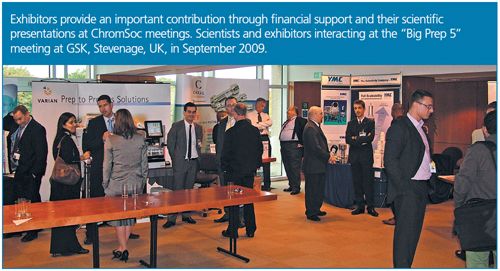
Q. Ten years ago during the 50th anniversary of The Chromatographic Society some predictions were made by one of your members. Briefly they were: built in injectors/detectors in the column; smart chips inside columns; and the end of analytical separations due to dynamic field gradient focusing. Firstly, how close to the truth were these predictions and secondly what are your predictions for advances in the field of separation science in the next 10 years?
A: This sounds very much like comments from the good Professor Myers at the University of Liverpool, who was a previous member of our committee and continues to be a keen supporter of our activities! I think that he was right in a couple of areas in that there is an increased interest in labâonâa-chip technology that have integrated injection systems, but detectors are still largely separate from the fluidic system. Smart chips haven’t reached a level where they are embedded in the column yet, but as many of your readers will know, some UHPLC columns have smart chip cords that contain limited data regarding the use of the column, for example, the number of injections and highest pressure observed.
Giddings first discussed dynamic field gradient focussing in the early 1970s - so it’s not that new a technique. There have been a number of articles discussing its application over the last 10 years, but it hasn’t been widely adopted as an analytical technique. One area that I do see more uptake of, particularly in the field I work in, is the use of electrophoresis for analysis of biomolecules. All major pharmaceutical companies are developing novel biotherapies, be these mAbs, oligonucleotides, peptide therapies etc, and I believe electrophoresis will play an increasingly important role in the next 10 years. In terms of what I expect to see in the next decade, I think we will see development of more portable or point-of-analysis chromatography systems (including microfluidic systems) and also the development of simpler and more robust UHPLC systems, which may be dedicated for specific analysis types.
I also think we’ll see much more focus on multidimensional chromatography and 3D chromatography, which Peter Schoenmaker’s group at the University of Amsterdam is working on - they could become a commercial product in this time. This will also require further developments in informatic solutions to deconvolute the complex data sets associated with multidimensional separations in order to speed-up the conversion of data into knowledge. I also believe that with the recent advances in supercritical fluid chromatography (SFC) technology by multiple vendors, this will become a more widely adopted technology.
One technology that I find particularly exciting is the paper diagnostic tests that Georges Whiteside’s group at Harvard University are pioneering. Being able to produce simple diagnostic tests fabricated from paper for use in the developing world could be a game changer for global healthcare. While I’m probably stretching this as a chromatograph technique (it’s principally driven by capillary forces), why couldn’t we start thinking about making separation systems from simple disposable materials or using 3D printers? One thing I can say, I definitely don’t want to see higher-pressure UHPLC pumps or smaller particle stationary phases. I think we’ve reached the practical limits to that approach in separation science. Making higher pressure pumps will almost certainly lead to even more robustness issues with these types of systems.
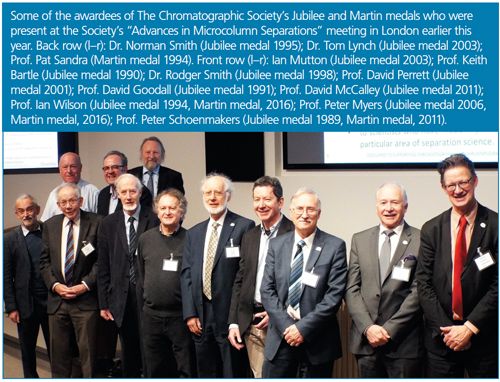
Q. Returning to the present, how exactly does the Chromatographic Society plan to celebrate its 60th birthday?
A: This year we have a very busy set of meetings and events. As mentioned earlier, we revisited our history by holding our first meeting at the Institute for Engineering and Technology in London, which had an exceptional speaker line-up.
The second meeting of the year we are supporting is the ISC2016 meeting in Cork (Ireland - 28 August–1 September) where we are inviting a number of speakers to present on behalf of the Society. This will be the largest chromatography meeting of the year in Europe and a “must attend” event for separation scientists.
Our third meeting of the year will be held on 25 October at the agrochemical company Syngenta (Bracknell, UK). This meeting will be focused on separation science and automation in industry. We have unfortunately had to rearrange this meeting because of the the closure of the MSD pharmaceutical site at Hoddesdon, which is where we were originally hoping to hold this event in Spring.
As mentioned earlier, we will continue to work with partner organizations and to this end once again we will be working with the RSC separation science group on the popular “Advances in Clinical Analysis” meeting, which will be held in the RSC’s Burlington House, London on the 30th November.
We propose our final “meeting” of our five planned events of 2016 will be held on the 14–17 October, which will be an educational event focusing on the development of postgraduate researchers and novice chromatographers. We are holding this meeting in the Lake District, and the programme will be a mixture of tutorials, lectures, and poster presentations alongside a social programme taking in some of the attractions of this part of the world and offering excellent networking opportunities. Certainly in my time with the Chromatographic Society, we have focused on delivering meetings based on invited speaker lectures. An event such as this is an ambitious step for the current committee and one which we hope will become another important fixture in our calendar.
So we have lots to focus on this year and we hope your readers, particularly in the UK, will help support these events and help us to reinvigorate separation science in the UK.
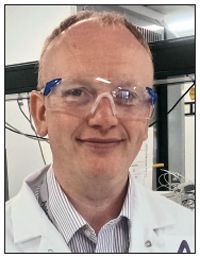
Paul Ferguson is a separation science specialist at AstraZeneca in the UK, and leads the separation science strategy for their product development division working on both small- and medium-size novel therapies. He has worked in the pharmaceutical industry since 1999 (previously at Pfizer) following a postâdoc at Imperial College London on capillary electrochromatography (CEC) with Dr Norman Smith. Paul has particular interests in UHPLC, SFC, CE, chiral separations, formulated drug sample preparation, green analytical chemistry, and method development. He is a past winner of the Desty Memorial lecture prize (2002), a Fellow and Chartered Chemist in the RSC, and is a visiting lecturer at Kings College London where he has lectured on the MSc Analytical Science for Industry course since its inception in 2009.
Paul is also the President of The Chromatographic Society in the UK. He has organized or co-organized several successful UK symposia for the Society since 2007 and is involved with the organization of two meetings as part of the Society’s Diamond Jubilee celebrations in 2016.
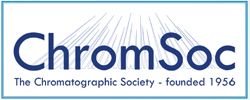
E-mail:chromsoc@meetingmakers.co.uk • Website:www.chromsoc.com
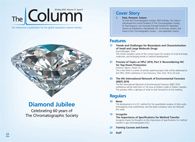
Measuring Vitamin K1 Concentrations in Dogs with Chronic Enteropathy Using LC–MS/MS
May 14th 2025A joint study between the University of Tennessee (Knoxville, Tennessee) and the University of Pennsylvania School of Veterinary Medicine (Philadelphia, Pennsylvania) compared directly measured vitamin K1 (vitK1) concentrations in healthy dogs and dogs with chronic enteropathy (CE) using liquid chromatography tandem mass spectrometry (LC–MS/MS); they also investigated whether supplementation of vitK1 in dogs with CE would significantly increase vitK1 concentrations.
HPLC 2025 Preview: Fundamentally Speaking (Part 2)
May 14th 2025Michael Lämmerhofer from the Institute of Pharmaceutical Sciences, University of Tübingen, Germany, spoke to JFK Huber Lecture Award winner of 2024 Torgny Fornstedt, professor in analytical chemistry and leader of the Fundamental Separation Science Group, Karlstad University, Sweden, about his pioneering work in high performance liquid chromatography (HPLC) with a focus on fundamentals, ion-pair chromatography, and oligonucleotide applications.

.png&w=3840&q=75)

.png&w=3840&q=75)



.png&w=3840&q=75)



.png&w=3840&q=75)











